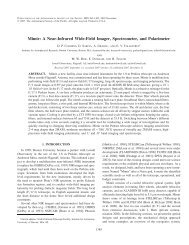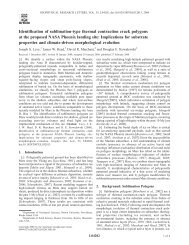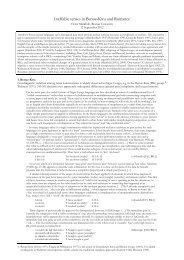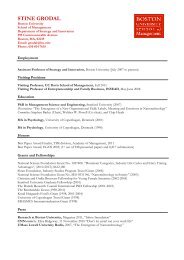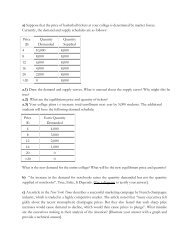3. On the subdomain C × M, we obtain a pure risk setting where only the second-stager<strong>and</strong>omization is present. In this case, the model reduces to (12).4.4. Risk Aversion <strong>and</strong> <strong>Ambiguity</strong> AversionAs discussed before, the function W describes intertemporal substitution. Now, we discusshow ambiguity aversion is separated from risk aversion in the two-stage r<strong>and</strong>omization approach.We begin by characterizing risk aversion. In doing so, we restrict attention to thesubdomain C × ∆ (L) without subjective uncertainty. In this case the utility representationtakes the form in (18). Because there is two-stage r<strong>and</strong>omization, we have two risk attitudestoward the risk in the two stages (or in the first-order <strong>and</strong> the second-order).For the risk in the second stage, we remove the first-stage risk by assuming that the firststage lottery is degenerate. We then obtain the representation of recursive risk preferencegiven in (12). We can define risk aversion in the second stage in a st<strong>and</strong>ard way <strong>and</strong> showthat it is completely characterized by the concavity of u.Turn to risk aversion in the first stage. We define absolute risk aversion in the first stageas follows:Definition 7 The decision maker with preference {≽ s t} exhibits risk aversion in the firststage if for all s t , c ∈ C <strong>and</strong> l, l ′ ∈ L, λ ∈ [0, 1],(c, δ[λl ⊕ (1 − λ)l ′ ]) ≽ s t (c, λδ[l] + (1 − λ)δ[l ′ ]). (19)We can similarly define risk loving <strong>and</strong> risk neutrality in the first stage. In Definition7, λδ[l] + (1 − λ)δ[l ′ ] ∈ ∆ (L) represents a lottery in the first stage <strong>and</strong> δ[λl ⊕ (1 − λ)l ′ ]represents a degenerate lottery over the mixture λl ⊕(1−λ)l ′ in the second stage. Accordingto this definition, the decision maker may not be indifferent between these two lotteries, eventhough they give the same final outcome distribution. In particular, if the decision makerbelieves that the degenerate lottery is like a sure outcome <strong>and</strong> must be preferred, then hedisplays risk aversion in the first stage.Note that if we replace ≽ s t with ∼ s t in (19), we obtain a dynamic counterpart of Seo’s(2009) Reduction of Compound Lotteries axiom. Thus, according to our Definition 7, violationof the Reduction of Compound Lotteries reflects the decision maker’s attitude towardthe risk in the first stage. The following proposition characterizes this risk attitude.Proposition 3 Suppose {≽ s t} satisfies Axioms B1-B7. Then {≽ s t} exhibits risk aversionin the first-stage if <strong>and</strong> only if v ◦ u −1 is concave.23
An immediate corollary of this proposition is that, given Axioms B1-B7, the Reductionof Compound Lotteries axiom is satisfied if <strong>and</strong> only if v ◦ u −1 is a strictly increasing affinefunction. In this case, the two lotteries l <strong>and</strong> a in (18) can be reduced to a compound lottery<strong>and</strong> hence (18) reduces to a model belonging to the class of recursive expected utility underobjective risk.Next, we consider comparative risk aversion.Definition 8 Say that {≽ i s t } is more risk averse than {≽ j s t } in the first stage if for all s t ,c ∈ C, l ∈ L <strong>and</strong> a ∈ ∆(L),(c, δ[l]) ≽ j s(c, a) =⇒ (c, δ[l]) ≽ i t st (c, a),<strong>and</strong> if this property also holds true for strict preference relations ≻ j s t <strong>and</strong> ≻ i s t .Take current consumption c as given. Suppose person j prefers a ‘sure’ outcome (withthe outcome being a lottery) to an arbitrary lottery for tomorrow. This must be due to j’saversion to risk. Facing the same choices, if person i is more risk averse than person j in thefirst stage, then person i should dislike what person j dislikes.Proposition 4 Suppose {≽ i s t } <strong>and</strong> {≽ j s t } satisfy Axioms B1-B7. Then {≽ i s t } is more riskaverse than {≽ j s t } in the first stage if <strong>and</strong> only if there exist corresponding utility representationssuch that V i | C×∆(L) = V j | C×∆(L) , W i = W j , u i = u j <strong>and</strong> v i = Ψ ◦ v j where Ψ is astrictly increasing <strong>and</strong> concave transformation.By Definition 8, persons i <strong>and</strong> j rank deterministic consumption plans in the same way<strong>and</strong> rank lotteries in the second stage in the same way. Thus, (W i , u i ) <strong>and</strong> (W j , u j ) areordinally equivalent. Proposition 4 shows that person i is more risk averse than person j inthe first stage if <strong>and</strong> only if v i is a monotone concave transformation of v j .Now, we consider ambiguity attitude. Because ambiguity attitude deals with subjectiveuncertainty, we focus on the subdomain C × ∆ (H +1 ) in which uncertainty resolves in justone period. We define absolute ambiguity aversion as follows.Definition 9 The decision maker with {≽ s t} exhibits ambiguity aversion if for all s t , c ∈ C,h +1 , h ′ +1 ∈ H +1 , <strong>and</strong> λ ∈ [0, 1],(c, δ[λh +1 ⊕ (1 − λ)h ′ +1]) ≽ s t (c, λδ[h +1 ] + (1 − λ)δ[h ′ +1]). (20)24
- Page 1: Intertemporal Substitution andRecur
- Page 6 and 7: As in KMM (2005, 2009a), we impose
- Page 8 and 9: 2. Review of the Atemporal ModelsIn
- Page 10 and 11: defined over it. Notice that by res
- Page 12: For any c ∈ C, we use δ[c] to de
- Page 15: The axiom below states that the pre
- Page 18: is ambiguity averse if he prefers a
- Page 22 and 23: Axiom B6 (Dynamic Consistency) For
- Page 26 and 27: We can similarly define ambiguity l
- Page 28 and 29: epresentations under these two appr
- Page 30 and 31: where R t+1 is the market return fr
- Page 32 and 33: Segal (1987, 1990) and Seo (2009).
- Page 34 and 35: A Appendix: Proof of Theorems 1 and
- Page 36 and 37: Define v = ψ ◦ ū −1 ◦ u, wh
- Page 38 and 39: compute:∫˜ū (m) =∫=∫=∫= A
- Page 40 and 41: DefineH = {h = (h 0 , h 1 , h 2 ,
- Page 42 and 43: Lemma 5 We have the homeomorphic re
- Page 44 and 45: Finite-step-ahead acts and densenes
- Page 46 and 47: which is strictly increasing in the
- Page 48 and 49: where the second equality follows f
- Page 50 and 51: D Appendix: Proofs for Section 4.4P
- Page 52 and 53: This relation holds true because i
- Page 54 and 55: In complete markets, the following
- Page 56 and 57: Ergin, H. I. and F. Gul (2009): “
- Page 58: Weil, P. (1989): “The Equity Prem



